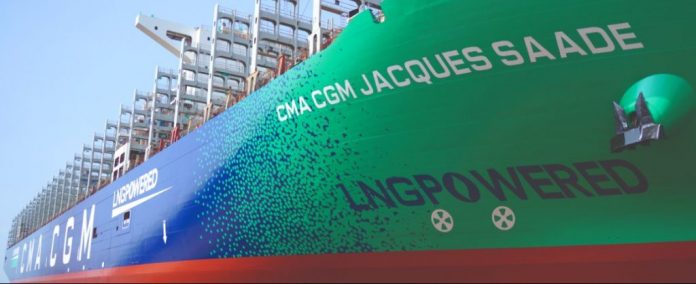 Regulatory drivers along with growing environmental pressure from shippers, consumers and investors means container shipping faces an acute need to decarbonise and cut air pollution. With regulations around SOx, NOx, PM and black carbon only likely to intensify, ship operators should consider clean technology solutions designed with the future, not the past, in mind, says Neil Anderson CMO at Daphne Technology.
Regulatory drivers along with growing environmental pressure from shippers, consumers and investors means container shipping faces an acute need to decarbonise and cut air pollution. With regulations around SOx, NOx, PM and black carbon only likely to intensify, ship operators should consider clean technology solutions designed with the future, not the past, in mind, says Neil Anderson CMO at Daphne Technology.
Environmental regulatory change in shipping has never been so intense and so rapidly changing, and now poses perhaps the most significant risk factor faced by today’s ship owners and operators.
We can be almost certain that January 2020 was only the first staging post, as regulations – including MARPOL Annex VI, which limits the main air pollutants contained in ships exhaust gas – tighten further over the coming years. Moving forward, stricter NOx restrictions, as well as further overarching restrictions on SOx and PM, are all realistic possibilities.
On top of this, shipping’s need to decarbonise is undoubtedly the most significant existential challenge the industry has faced in decades, with the International Maritime Organization’s (IMO) Fourth Greenhouse Gas (GHG) Study – published in August 2020 – revealing that shipping’s relative contribution to the climate crisis is continuing to grow exponentially.
Overlay this regulatory uncertainty with the Covid-19 pandemic and the resulting economic slowdown, and the container shipping industry faces a truly unique challenge, all the while echoed by a dramatic acceleration of calls from shippers, consumers and investors for the sector to “clean up” its operations.
IMO 2020 – an evolving approach
When it came to assessing solutions for compliance with the IMO’s global sulphur limit, the two most common compliance options – very-low sulphur fuels (VLSFO) and exhaust gas cleaning systems (scrubbers) have been the two key options for shipowners. Container ship owners and operators have long focused on their ability to utilise cargo per cubic metre, resulting in some decision makers shifting towards very low sulphur fuel oil (VLSFO), despite availability concerns – as scrubber units would take up considerable cargo space.
However, recent events present a changing picture. As the container industry has placed growing emphasis on the volume – and cost – of fuel used, there has been a renewed push for the installation of scrubbers. According to the latest analysis from Peter Sand, BIMCO’s Chief Shipping Analyst, the share of the containership fleet with scrubbers installed exceeded that of the crude oil tanker fleet.
At the time of writing (July 2020), the container shipping sector became the most scrubber-fitted sector amongst the main cargo carrying ship types. Sand was keen to point out that this trend was occurring, despite the current low bunker fuel price spread between high and very-low sulphur fuels.
“It’s safe to say that the investments are economically sound,” he commented. In its report, BIMCO goes on to flag that scrubbers are more popular with larger container vessels, specifically post-Panamax and ultra large container ships.
These vessels use more fuel and are therefore more likely to benefit from lower HFO prices, not least because bunkers bill represent the largest operating costs for container vessels. In other words economies of scale matter. Naturally, the economics become even more favourable if and when the spread between high and very-low sulphur fuels widens.
The uncertain regulatory trajectory
While some container ship owners double down on scrubber installations, the debate on their economics has been largely usurped by a broader conversation concerning other potential ways that MARPOL Annex VI could be tightened – with calls for environmental action galvanised by a new, progressive sentiment in the market, perhaps somewhat triggered by Covid-19.
As mentioned, tightening of NOx, PM and SOx limits remain likely; meaning that, when it comes to future-proofing container vessels against constantly changing regulations, legacy solutions such as wet water scrubbers should not be relied upon.
The technology underpinning such solutions was developed up to 40 years ago, and long before the development of current environmental regulations, meaning wet water scrubbers are rapidly becoming outdated. While they are effective in removing SOx in line with current IMO 2020 compliance levels, they create other significant pollution problems, including wash water discharge; a hotly debated topic in the shipping industry that is subject to intense scrutiny and evolving scientific opinion, as well as strict IMO monitoring.
Current concerns are being taken seriously by the industry, with 221 countries around the world, having already banned wash water discharge. This means shipowners with wet scrubbers installed must turn their units off while in these areas. The same vessel owners may have also invested in a separate SCR or EGR systems to remove NOx and ensure compliance.
There is another route for container ship owners and operators looking to pollution agnostic solutions that safeguard profitability while future-proofing their assets against the intensifying of environment regulations. This route could cut their reliance on outdated legacy solutions.
Tackling SOx and NOx simultaneously
Daphne Technology aims to look beyond the regulation and at the challenge of SOx and NOx reduction holistically, but while also continuing to work within frameworks to unlock challenges that already exist.
Through our technology-first air purification approach, we have developed the world’s first solution that reduces both SOx and NOx pollutants from marine exhaust gas systems. Our turnkey solution SulPure removes SOx and NOx pollutants simultaneously and negates the necessity for further investment in (and the loss of space on a container vessel for) NOx SCR and EGR systems, as well as additional future SOx abatement.
We seek to use our technology, not only to capture pollution before its released, but also to upcycle pollutants. This can be seen with our SulPure system, which transforms SOx and NOx pollutants into a market-ready fertiliser for the global agricultural industry.
Utilising this unique agricultural method significantly reduces greenhouse gas emissions, while supporting the development of the circular economy. Ultimately, this approach will reduce pressure on the environment, add resilience to raw material supply chains and increase competitiveness, while stimulating innovation and boosting economic growth.
The first installations of SulPure, incorporating three 7MW systems, are set to be completed in 2021. The system represents a shift in the approach to abatement technology in shipping, and, for us, represents the start of our journey.
Addressing methane slip
Another incoming challenge for shipping – including the container segment – was highlighted most recently in the IMO’s Fourth GHG Study, which revealed that a 150% increase in methane emissions from 2012 to 2018 is to be expected, largely due to a surge in LNG fuelled ships. Container ship owners and operators are likely to be following this closely, not least as the container shipping market has thrown its hat into LNG as a marine fuel in a big way with heavy investment in LNG-ready vessels.
To reduce the total GHG emissions of LNG, direct methane slippage must be eliminated from a vessel’s stack. The study highlights the need for new technology to further reduce the global warming impact of LNG fuelled ships, and this perfectly demonstrates our mission to build on our pollutant molecule breakdown technology and explore new applications that can significantly reduce all air pollutants and carbon emissions from shipping.
We have already successfully demonstrated that our technology can optimise the environmental performance of LNG, including most significantly, direct CH4 (methane) slip.
A clean conclusion
While BIMCO’s analysis demonstrates the container segment’s interest in scrubbers, liner ship owners and operators should not have to rely on legacy solutions, which have swiftly become antiquated and not fit for purpose. Instead, more onus needs to be placed on re-thinking expectations around exhaust purification beyond exhaust gas cleaning systems’ capacity to respond to MARPOL Annex VI revisions; widening the opportunity to invest in technologies that can future-proof against multiple emissions, including LNG fuelled propulsion.
A more flexible approach to technology development that is pollution, fuel and vessel agnostic will deliver the impact and speed of change the container shipping industry needs to meet our environmental goals and achieve compliance.
Neil Anderson, CMO, Daphne Technology
 As CMO of Daphne Technology, Neil oversees all marketing efforts while supporting the growth of the company. Having worked in marketing and sales for more than 30 years, Neil knows what it takes to position and build brands and products in the marine segment.
As CMO of Daphne Technology, Neil oversees all marketing efforts while supporting the growth of the company. Having worked in marketing and sales for more than 30 years, Neil knows what it takes to position and build brands and products in the marine segment.
After a brief stint in the automotive sector, Neil embarked on a career in the yacht sector, which ultimately led to him to working in the wider marine sector. For 20 years, Neil worked at DuPont, working his way up the ladder to Corporate Director of Marketing and Sales for the Marine Industry. Following this, Neil worked at the French industrial engineering company CNIM as its Commercial Director for Marine Technologies, before joining Daphne Technology.







